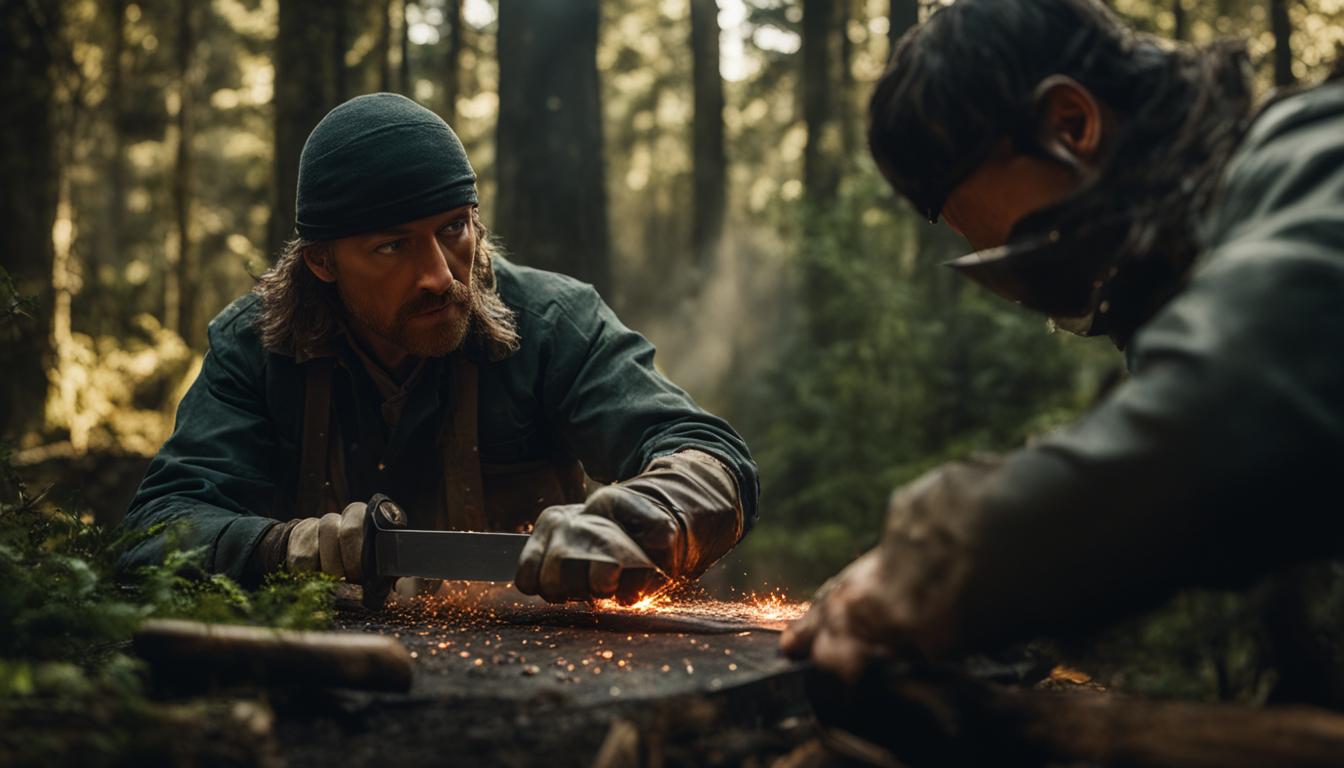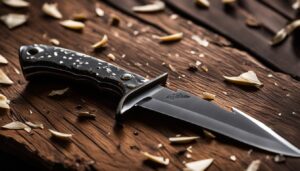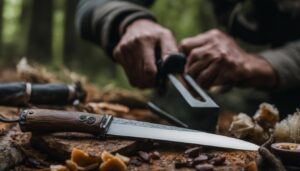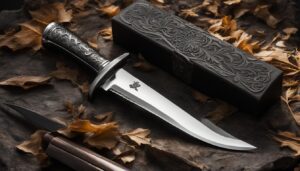Maintaining a sharp hunting knife is crucial for a successful hunting season. A sharp knife makes fieldwork easier and ensures clean cuts, resulting in less wasted meat and a reduced risk of injury. Before heading out on a hunt, it is important to sharpen your knives to a consistent angle and carry a sharpener to maintain the edge in the field. Regularly honing the knife during field dressing will also help maintain its sharpness.
Key Takeaways:
- Sharpen your hunting knife to a consistent angle before heading out on a hunt.
- Carry a sharpener with you to maintain the edge in the field.
- Regularly hone the knife during field dressing to keep it sharp.
- A sharp hunting knife ensures clean cuts, reduces wasted meat, and minimizes the risk of injury.
- By maintaining a sharp hunting knife, you can improve your hunting experience and increase your chances of a successful season.
The Importance of a Sharp Hunting Knife
When it comes to hunting, having a sharp knife is absolutely essential. A sharp hunting knife allows for clean and precise cuts, reducing the risk of jagged or uneven cuts that can result in wasted meat or potential injury. Maintaining the sharpness of your hunting knife should be a top priority for any serious hunter.
Not only does a sharp knife make fieldwork easier, but it also ensures that you can efficiently dress and process your game in the field. A dull knife requires more force to make cuts, increasing the chances of accidents and potentially ruining the meat. A sharp knife, on the other hand, allows you to make clean cuts with minimal effort, guaranteeing a successful hunt.
“A dull knife is both frustrating and dangerous. Take the time to maintain the sharpness of your hunting knife, and you’ll never regret it.”
Regularly honing your hunting knife is crucial for maintaining its sharpness. Honing helps to realign the blade and remove any slight burrs that may have formed during use. It’s a simple process that can be done with a ceramic or leather strop. By honing your knife regularly, you can keep it razor-sharp, ensuring that it performs at its best when it matters most.
| Benefits of a Sharp Hunting Knife |
|---|
| Clean and precise cuts |
| Reduced risk of wasted meat |
| Decreased chance of injury |
| Efficient field dressing and processing |
By prioritizing the maintenance of your hunting knife, you can ensure that it remains sharp and ready for action. Take the time to sharpen and hone your knife regularly, and you’ll be rewarded with a tool that enhances your hunting experience and increases your chances of a successful hunt.
Preparing Your Knives for the Hunt
Before embarking on a hunting trip, it is crucial to ensure that both your folding knife and fixed blade are sharp. By following proper knife maintenance practices, you can enhance your hunting experience and maximize your chances of success. Here are some essential steps to help you prepare your knives for the hunt:
Step 1: Sharpening the Blades
Start by sharpening both your folding knife and fixed blade to the same angle, typically around 20° per side. This consistency will make it easier to maintain the edge in the field. Use a high-quality sharpening stone or system to achieve a precise and durable edge. Remember to match the factory bevel by blackening the edge with a felt marker, ensuring the correct blade angle.
Step 2: Choosing the Right Sharpener
Choosing the right sharpener is essential for maintaining the sharpness of your hunting knives. Consider using a sharpener that matches the sharpening angle of your blades. This will eliminate the need for angle changes and ensure efficient sharpening and honing in the field. Invest in a compact and portable sharpener that can easily fit in your hunting gear.
Step 3: Regular Maintenance During the Hunt
While on your hunting trip, regularly inspect and maintain the sharpness of your knives. Use your sharpener to touch up the edge as needed, especially after field dressing game. A quick hone during field dressing will help restore the edge and maintain its sharpness. Remember, a sharp knife requires less force to make cuts, resulting in cleaner and more precise cuts, less wasted meat, and a reduced risk of injury.
| Benefits of Preparing Your Knives | Effects of Neglecting Knife Maintenance |
|---|---|
|
|
By following these steps and maintaining the sharpness of your hunting knives, you can ensure a more enjoyable and successful hunting experience. Remember to always prioritize safety and handle your knives with care. Stay sharp and good luck on your hunts!
“A sharp knife is an essential tool for any hunter. Properly preparing and maintaining your knives before the hunt ensures clean, precise cuts and reduces the risk of injury. Don’t overlook the importance of knife maintenance – it can make all the difference in your hunting experience.”
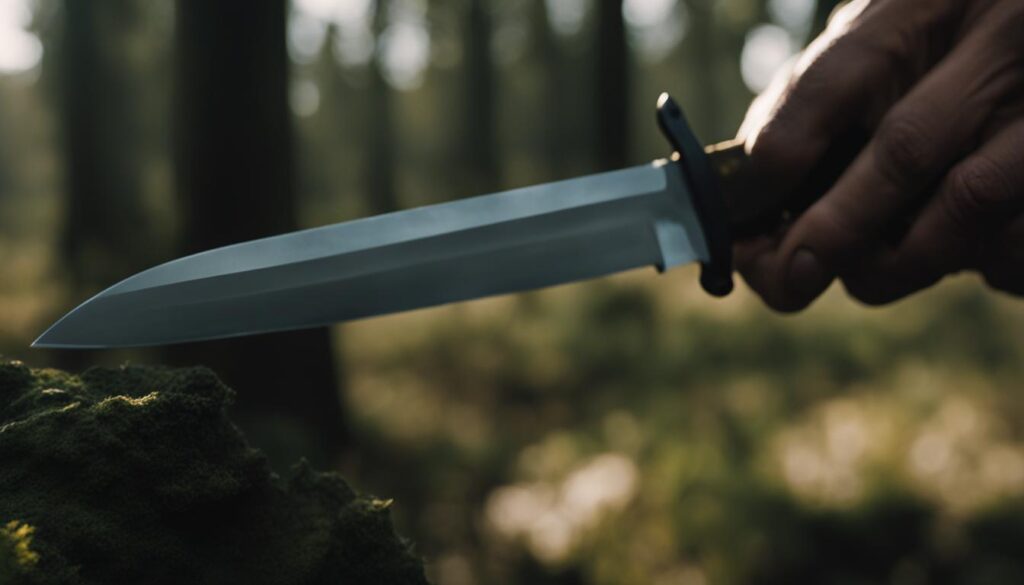
Maintaining Sharpness During Field Dressing
During field dressing, it is essential to pay close attention to the performance of your hunting knife. A sharp knife makes clean and precise cuts, reducing the risk of wasted meat and potential injury. When you notice that your knife requires more pressure or the cuts become sloppy, it is time to hone the edge to maintain its sharpness.
One effective method of honing the knife during field dressing is by using a ceramic or leather strop. With the knife blade at a consistent angle, gently draw the edge across the strop’s surface, alternating sides until a razor-sharp edge is achieved. Regularly honing the knife during field dressing ensures efficient and successful hunts, as it requires less force to make cuts and results in cleaner, more precise cuts.
By maintaining the sharpness of your hunting knife during field dressing, you not only improve your hunting experience but also reduce the risk of accidents or injuries. A sharp knife allows for easier and more efficient fieldwork, ensuring that you maximize your harvest while minimizing waste. Remember to always carry a sharpening tool and regularly inspect your knife’s sharpness during field dressing to maintain optimal performance.
The Benefits of Honing Your Knife:
- Cleaner and more precise cuts
- Reduced risk of wasted meat
- Minimized risk of injury
- Improved overall hunting experience
“A sharp knife is a hunter’s best friend. It allows for clean and effective field dressing, ensuring that no meat goes to waste and accidents are avoided.” – Experienced Hunter
Matering the Art of Knife Sharpening
Proper knife sharpening is essential for maintaining a sharp hunting knife. By mastering the technique of creating a burr, you can achieve a razor-sharp edge that will enhance your hunting experience. Most sharpening methods focus on abrading material from the bevel of the knife to create a burr on the opposite side. This burr is then gradually reduced to a microscopic filament through the use of finer stones or strokes.
To start the sharpening process, blacken the edge of your knife with a felt marker to ensure the correct blade angle. Use a wet stone or sharpening system that suits your preference, and make long, sweeping pull strokes along the length of the blade. Apply even pressure and utilize the entire stone to maintain consistency. After creating a burr on one side, switch to the other side and repeat the process.
Gradually reduce the burr by using finer stones or strokes until it becomes almost microscopic. This will result in a sharp edge with an appropriate angle, typically around 20° to 24°, for optimal performance. Finish the sharpening process with a fine-grit stone or strop to achieve a mirror finish. By using these proper sharpening techniques, you can extend the lifespan of your hunting knife and ensure long-lasting sharpness.
Remember to always prioritize safety when sharpening your knife. Keep your fingers away from the blade and use caution to avoid accidents. With practice and patience, you can become proficient in the art of knife sharpening and maintain your hunting knife’s sharpness for years to come.
Table: Recommended Sharpening Angles for Different Types of Knives
| Type of Knife | Recommended Angle |
|---|---|
| Hunting Knife | 20° to 24° |
| Fillet Knife | 15° to 20° |
| Pocket Knife | 20° to 25° |
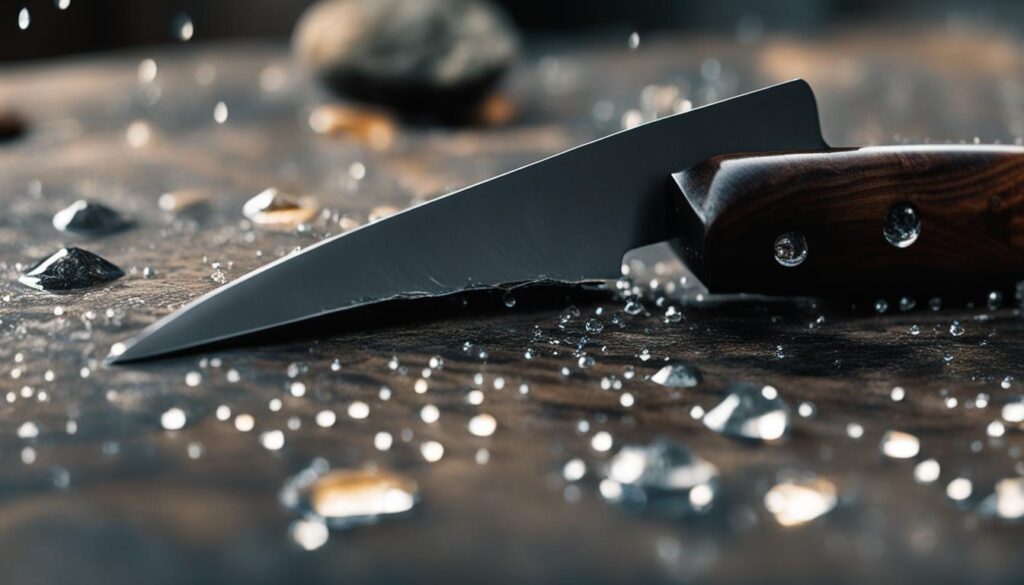

Sharpening Techniques for Long-Lasting Sharpness
When it comes to maintaining the sharpness of your hunting knife, using the right sharpening techniques is essential. By following these methods, you can ensure that your knife retains its edge for longer, allowing for successful and efficient hunts.
One effective method is using a wet stone or sharpening system that suits your preference. To start, match the factory bevel by blackening the edge with a felt marker, ensuring the correct blade angle. Then, make long, sweeping pull strokes along the length of the blade, applying even pressure and utilizing the entire stone.
After creating a burr, switch sides and repeat the process. Gradually reduce the burr through finer stones or strokes until it is almost microscopic. Finally, finish off with a fine-grit stone or strop to achieve a mirror-like finish.
Summary of Sharpening Techniques:
- Use a wet stone or sharpening system
- Match the factory bevel
- Make long, sweeping pull strokes
- Apply even pressure
- Utilize the entire stone
- Create and reduce the burr
- Finish with a fine-grit stone or strop
“Using the right sharpening techniques can make a significant difference in maintaining the sharpness of your hunting knife. By following these methods, you can ensure that your knife remains sharp for years, improving your hunting experience.” – Knife Sharpening Expert
Conclusion
Maintaining a sharp hunting knife is essential for a successful hunting season. By following proper sharpening and honing techniques, you can ensure clean and precise cuts, reduce wasted meat, and minimize the risk of injury. Sharpen your knives before heading out on a hunt to ensure they’re at their sharpest. Carry a sharpener with you to maintain the edge in the field. Regularly honing the knife during field dressing will also help maintain its sharpness.
A sharp hunting knife is crucial for effectively dressing and processing an animal in the field. It allows for clean and precise cuts, reducing the risk of uneven or jagged cuts that can result in wasted meat or injury. Honing the knife with a ceramic or leather strop helps maintain its sharpness and ensures efficient fieldwork. Pay close attention to how your knife edge is cutting during field dressing, and hone the edge when necessary.
Proper knife sharpening is crucial for maintaining a sharp hunting knife. Mastering the art of creating a burr and reducing it to a microscopic filament is key to achieving a sharp edge. Use a wet stone or sharpening system that suits your preference, and match the factory bevel by blackening the edge. Make long, sweeping pull strokes along the length of the blade, applying even pressure. Gradually reduce the burr through finer stones or strokes until it is almost microscopic. Finish with a fine-grit stone or strop to achieve a mirror finish and maintain the knife’s sharpness.
By caring for your knife with proper sharpening and honing techniques, you can extend its lifespan and maintain its sharpness for years. A sharp hunting knife improves your hunting experience and enhances your chances of a successful season. So, remember to stay sharp and good luck on your hunts!
FAQ
Why is maintaining a sharp hunting knife important?
Maintaining a sharp hunting knife is important because it allows for clean and precise cuts, reducing the risk of uneven or jagged cuts that can result in wasted meat or injury.
When should I hone the edge of my hunting knife?
You should hone the edge of your hunting knife when you notice the need for more pressure to make a cut or when your cuts become sloppy and jagged. Regularly honing the knife with a ceramic or leather strop helps maintain its sharpness.
What angle should I sharpen my hunting knife to?
It is recommended to sharpen your hunting knife to a consistent angle, typically around 20° per side. This ensures consistency and ease of resharpening in the field.
What type of sharpener should I use for my hunting knife?
It is important to choose a sharpener that matches the sharpening angle of your knife. This eliminates the need for angle changes and ensures efficient sharpening and honing in the field.
How do I maintain the sharpness of my hunting knife during field dressing?
Pay close attention to how your knife edge is cutting during field dressing. When you notice the need for more pressure or your cuts becoming sloppy, it’s time to hone the edge. Honing the knife with a ceramic or leather strop helps restore and maintain its sharpness.
What is the key to effective knife sharpening?
The key to effective knife sharpening lies in mastering the burr. Most sharpening methods focus on abrading material from the bevel of the knife to create a burr on the opposite side. Producing an even burr along one side of the edge and then reducing it to a microscopic filament through alternating fine stones or strokes results in a sharp edge.
What sharpening techniques should I use for my hunting knife?
To sharpen your hunting knife effectively, use a wet stone or sharpening system that suits your preference. Match the factory bevel, make long sweeping pull strokes along the length of the blade, and gradually reduce the burr through finer stones or strokes until it is almost microscopic.
